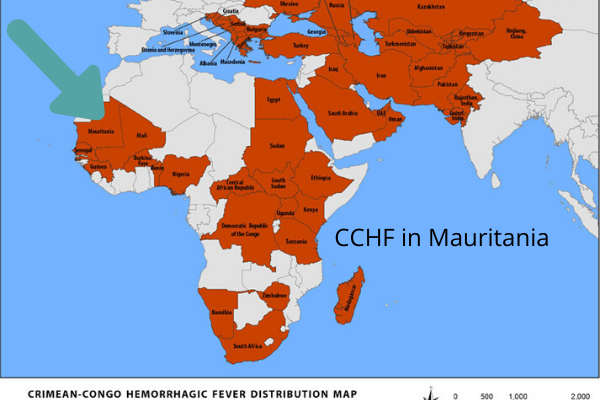By NewsDesk @infectiousdiseasenews
The World Health Organization (WHO) reported this week on a confirmed case of Crimean-Congo hemorrhagic fever (CCHF).
 The case is a 60-year-old butcher from Tiguent, Mauritania presenting symptoms of fever, fatigue, headaches and epistaxis, with onset on 2 May 2020. He had a history of handling of the carcasses of meat and no recent travel history.
The case is a 60-year-old butcher from Tiguent, Mauritania presenting symptoms of fever, fatigue, headaches and epistaxis, with onset on 2 May 2020. He had a history of handling of the carcasses of meat and no recent travel history.
He presented at a health facility of 7 May 2020 and a sample was collected for testing following the suspicion of a viral hemorrhagic fever disease. The case-patient was evacuated the same day in the Emergency Department in Nouakchott for further care. On 8 May 2020, the case was confirmed with CCHF by RT-PCR from the INRSP and transferred to the infectious diseases department where he was isolated and treated.
Crimean-Congo hemorrhagic fever is a widespread disease caused by a tick-borne virus (Nairovirus) of the Bunyaviridae family. The CCHF virus causes severe viral hemorrhagic fever outbreaks, with a case fatality rate of 10–40%.
Animals become infected by the bite of infected ticks and the virus remains in their bloodstream for about one week after infection, allowing the tick-animal-tick cycle to continue when another tick bites. Although a number of tick genera are capable of becoming infected with CCHF virus, ticks of the genus Hyalomma are the principal vector.
The CCHF virus is transmitted to people either by tick bites or through contact with infected animal blood or tissues during and immediately after slaughter. The majority of cases have occurred in people involved in the livestock industry, such as agricultural workers, slaughterhouse workers and veterinarians. Human-to-human transmission is possible.
- Paraguay: Dengue, measles vaccines and COVID-19
- Sweden officials produce guidance on how to assess freedom of COVID-19 infection
- Dengue fever: Locally acquired case reported in Miami-Dade County
- Emerging mosquito-borne viral diseases causing serious issues in west Africa
- Moscow tick activity down, Lyme disease cases same as last year
- Coronavirus vaccine: Moderna announces positive interim Phase 1 data

